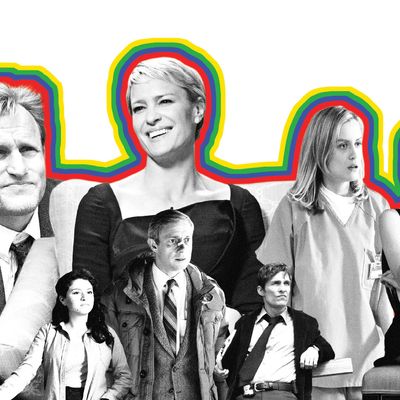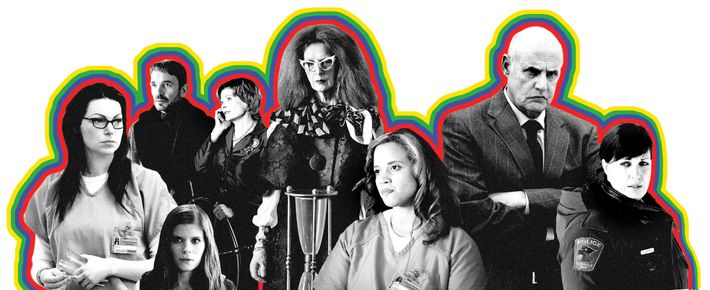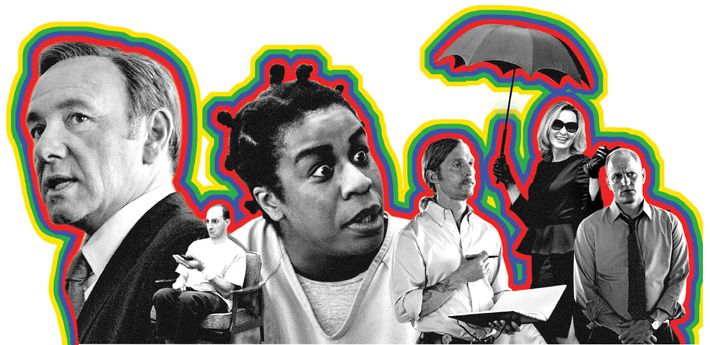
Nobody saw it coming.
On December 21, 2011, the season-one finale of FX’s American Horror Story baffled viewers by killing every last one of the show’s main characters. But an even bigger shock came the next day, when co-creator Ryan Murphy revealed during a conference call with reporters that his bloody campfest was not a traditional drama but a hybrid of the mini-series and the anthology and that the show would start again in season two with a new story and some of the same actors in different roles. “Every season of the show will be a different haunting,” Murphy said, springing one last prankish surprise on an audience that had been wondering how in unholy hell the show could possibly continue. Turns out it was just going to start all over again: series, shmeries.
Since TV took recognizable shape in the ’60s, it’s been a slave to established formats. Every ongoing series had to air a set number of episodes per season (somewhere between 13 and 26). An episode ran 30 or 60 minutes, depending on whether it was a comedy or a drama. All story lines had to tie up neatly at the end, except for the occasional Very Special Episode or season-ending cliffhanger. Any program that did not fit those labels had to be clearly marked with another label, such as mini-series or movie of the week. Later came premium-cable innovations like shorter seasons and stories that spread out over ten or more episodes. But for the most part, any experimentation was still encumbered by the rigid definitions of what shows could and couldn’t be. Premillennial TV was often denigrated as “the box,” not just because the appliance was cube-shaped but because its storytelling was packed into boxes, too.
These days, less so. Now that we’ve seen HBO’s True Detective (a cop show that will move to a new city and follow a different set of crime-solvers each season) and FX’s TV adaptation of the Coen-brothers movie Fargo (a series of self-contained ten-hour movies with few recurring characters), we’re not as startled by the idea of a hybrid mini-series–anthology. This fertile second phase in TV’s new golden age has taught us that the only rule is that there are no rules and that the final creative frontier is form. Broadcast shows are getting more-compact, cable-style episode orders (12 for the new season of 24, which used to always run, well, 24). We’re also seeing commercial cable networks such as FX indulge regular series with elastic running times. FX’s Sons of Anarchy, for example, is officially a one-hour drama, but in its most recent season, 8 of its 13 episodes ran in 90-minute time slots and the finale ran for almost two hours.

The mini-series–anthology is already looking like TV’s next big thing, in part because it removes many of the remaining barriers to drawing film talent. Shorter seasons cure artists’ fear of being trapped in the gilded cage of a long-running hit: Acclaimed director Cary Fukunaga (Jane Eyre) signed on to helm all eight episodes of True Detective, and Matthew McConaughey and Woody Harrelson agreed to star, because the show’s eight-and-out structure let them walk away without causing any problems. The mini-series–anthology model also lessens performance anxiety: Producers, writers, and actors don’t have to worry about prolonging a story beyond its natural end point or reviving a withering show, because every season finale is a prelude to a reboot. Season three of American Horror Story, for example, was a witches’ brew of bad ideas, but we don’t mind too much because it’s a one-off. There’s no pressure on creators Murphy and Brad Falchuk to dig themselves out of a hole; they can just leave the hole where it is and put their energy into making season four as good as one and two. They could even pull a True Detective and hire a horror auteur like Wes Craven or John Carpenter to oversee all 13 chapters.
Perhaps even more exciting, the old distribution models are shattering, too. Certain series stick with tradition and debut a new episode every week. Others dump complete seasons on Netflix all at once. Sometimes blocks of ten or more episodes are made knowing they’ll be binge-watched in the space of days. This makes the TV experience less communal (having to wait a week for a new chapter keeps millions of viewers on more or less the same page), but the upside is greater latitude for structural daring. One need only watch Netflix’s Orange Is the New Black and Arrested Development—which was resurrected by the streaming service for a fourth season last year—to understand how the all-at-once model has empowered writers to play around with structure and distribute screen time democratically among characters. Both shows dipped in and out of subplots and hopped between past and present with a novelist’s agility. Viewers were more inclined to let a scene or sequence play out before taking to the internet and asking why Orange was giving flashbacks to characters we’d just met, because they knew that the next episode in their queue could answer their questions. Arrested Development used the streaming model to solve actors’ scheduling problems (building episodes around one or two Bluths instead of the entire clan) and play storytelling games in the process. The second half of season four revealed that moments you assumed were self-contained were actually connected: Characters barely missed running into each other in a tobacco shop or sat rows apart on a plane ride without realizing it.
Binge-watchers are able to keep the totality of the story in their minds as they watch each new installment in a way that week-by-week viewers can’t. Arrested Development and Orange Is the New Black tell tangled stories that cohere better if you take them all in one dose; Netflix’s House of Cards, not as much, but it uses a compressed viewing schedule to allow for more complicated plots and politicking and also to sprint through implausibility—Vice-President Frank Underwood’s murder spree, for example. When you can watch 10 or 12 hours of a show over the course of a few days, you have less opportunity to obsess over plotlines or episodes that aren’t doing it for you. If Showtime’s Homeland had been a Netflix show, viewers might have been more accepting of the dead ends and inane twists because they wouldn’t have been able to stew over all of them for a week in recap comments sections.

The anything-goes approach to storytelling even seems to have emboldened long-running dramas with a more classical sensibility. The 16-episode final season of Breaking Bad was split in two and played like a couple of truncated, self-contained, fully satisfying mini-seasons: a classic rise-and-fall narrative. The final stretch turned cliffhanger storytelling into a form of audience torture, ending chapters with jarring cuts to black that interrupted moments of astonishing rage, then skipping ahead in time the next week without telling us how the moment resolved, then backing up when it was ready to finish its thought. This kind of Rubik’s Cube storytelling would’ve been unthinkable ten years ago. Streaming made it possible by conditioning viewers to look forward to the next hour rather than dwelling on the last five minutes.
Ironically, though, this forward-looking period of TV history is less a rebellion against TV’s past than a reclamation of its earliest potential, fused to lessons learned from other countries and stoked by the thrill of watching the medium shape-shift in the early-21st century. If you grew up watching American broadcast TV in the ’70s and ’80s, you’d have had no idea that a mere generation earlier the medium was free and fertile enough to accommodate vaudeville-influenced variety shows, live productions of new plays, explanatory series about history and the arts, meticulously reported prime-time news specials about current events, anthologies such as The Twilight Zone and The Outer Limits, and the Dada clowning of Ernie Kovacs. And unless you watched British imports on PBS, you’d never have known that international TV had thrown the story boxes out and never looked back. In the U.K., it was possible to present characters in an array of formats. Since 1994, Steve Coogan’s nitwit entertainer Alan Partridge has appeared in mock news and talk shows, a single-camera sitcom, and a movie: Format, style, and running time vary depending on the filmmakers’ vision, and each incarnation is separated by years of downtime. In contrast to NBC’s recent, misbegotten remake of Prime Suspect, which hewed to the standard NBC weekly template, the original BBC version spread out the adventures of Detective Chief Inspector Jane Tennison over 15 years, in mini-series and movies running anywhere from 100 to 200 minutes. The difference between this way of making TV and the traditional U.S. method is the difference between a boutique confectioner’s kitchen and an M&M factory.
It’s taken an unconscionably long time for American TV to learn that one size does not fit all, but this lesson won’t be unlearned. From now on, the size and shape of television’s boxes will vary depending on what’s inside, and some containers won’t look like boxes at all. Considering that the word television has been morphing as well, this seems only fitting. The box once referred to the device whose squarish screen delivered all manner of programming. Now it refers to a particular set of expectations for storytelling. You can watch the stories on a 60-inch wall-mounted plasma-screen television, a desktop computer, an iPad, or an iPhone. We still call it “television” mainly to distinguish it from movies, which are generally more self-contained, though theatrical films have increasingly taken their storytelling cues from TV (and from comic books, where dense and endlessly rebootable stories have been the norm for 70 years). Television is becoming a medium in which function follows form. There’s a word for work like this, made in an atmosphere of excitement and freedom: art.
*This article appeared in the May 5, 2014 issue of New York Magazine.


